- Joined
- Feb 2, 2011
- Messages
- 2,093
NEW RELEASES FOR MAY 2023
WELLINGTON IN INDIA
THE BATTLE OF ASSAYE 1803
THE MARATHA EMPIRE
ARAB MERCENARY INFANTRY
The Battle of Assaye was a major battle of the Second Anglo-Maratha War fought between the Maratha Empire and the British East India Company. It occurred on 23[SUP]rd[/SUP] September 1803 near Assaye in Western India where an outnumbered Indian and British force under the command of Major General Arthur Wellesley (who later became the Duke of Wellington) defeated a combined Maratha army of Daulatrao Scindia and the Bhonsle Raja of Berar.
The battle was the Duke of Wellington’s first major victory and the one he later described as his finest accomplishment on the battlefield, even more so than his famous victories in the Peninsular War and his defeat of Napoleon Bonaparte at the Battle of Waterloo.
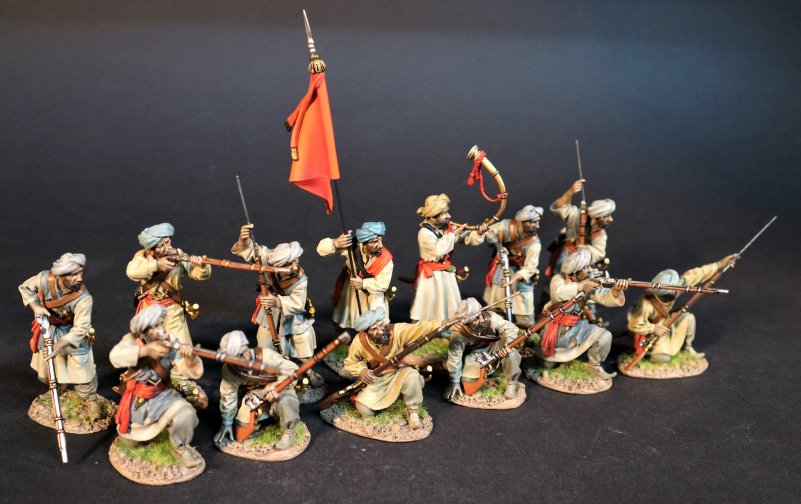
Kings, nobles and warlords have always imported mercenaries. Distrusting their own subjects, they placed faith on forces answering only to their benefactor. Through the ages, skilled and well-knit mercenary units have held inordinate power. Sometimes such units become so powerful that they turn on their employers on perceiving any threat. Sometimes, they even captured power. In India also, well-knit bands of Afghan, Turk, and African mercenaries have made great fortunes and captured power.
Arab mercenaries entered quite late in the game in India, when British supremacy had already emerged. Before the Arabs could expand their power in India — like so many foreign groups before them — their own benefactors and the British cut them down to size. However, their power and influence completely ended only in 1948.
The Sultans of Gujarat and the Deccan began employing Arab mercenaries in the 16th century. However, it was the Maratha campaigns of the 18th century that led to a huge influx. Arab mercenaries mostly hailed from Yemen’s Hadhramaut region, a land known for bold and enterprising people.
In the service of the Marathas, the Arabs gained reputation as extremely skilled and reliable fighters.
Thousands of Arabs served Maratha chieftains such as Scindia, Bhonsle and Gaekwad. Arab agents opened recruitment agencies in Indian ports, and some of these agents became very wealthy. Indian financiers also established ties with the Arabs to expand influence in Indian kingdoms.
Tribe and clan conflicts from the homeland existed in the mercenary units, but this did not dent their efficacy or their lustre.
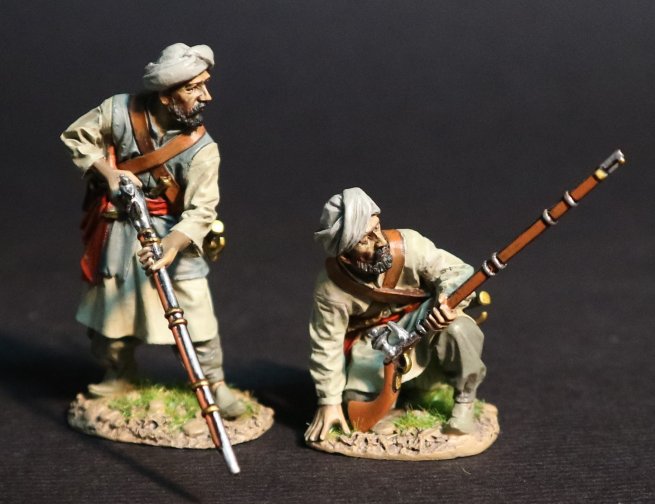
M-WIN-23
WELLINGTON IN INDIA,
THE BATTLE OF ASSAYE 1803,
THE MARATHA EMPIRE,
2 MARATHA ARAB MERCENARIES
(2 pcs)
An Arab trooper was paid three times as much as a Deccani/Maratha trooper, and even more than a European mercenary.
However, their service depended entirely upon the regularity and size of the pay. When arrears mounted, the Arabs turned on their employers till they received their dues. In one instance, the Arab mercenaries even intervened in a political crisis in Baroda state. They imprisoned Maharaja Anandrao Gaekwad and his faction had to invite the East India Company’s army to retake control.
The British were aware of the threat posed by the Arab forces — and the Anglo-Maratha wars soon demonstrated how deadly Arab units could be.
When Britain finally concluded the Anglo-Maratha wars in 1818, she ensured that the Arab mercenaries were disbanded.
The British even paid the arrears so that the Arabs could leave immediately.
MARATHA INFANTRY
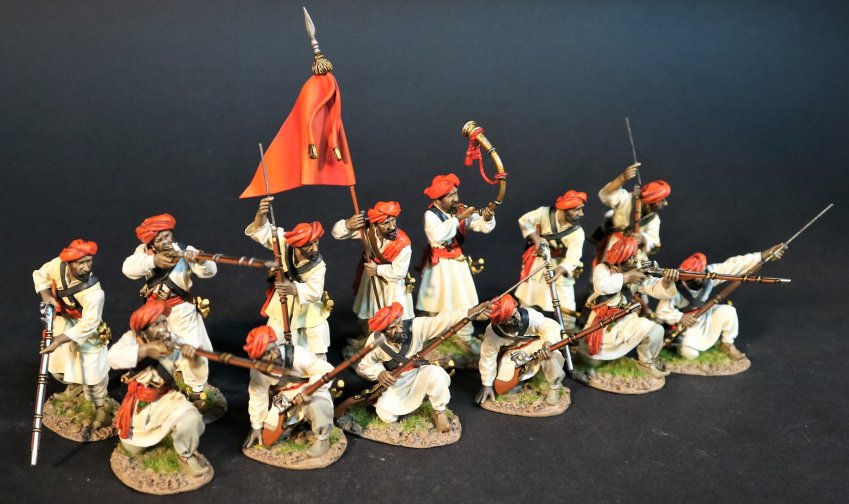
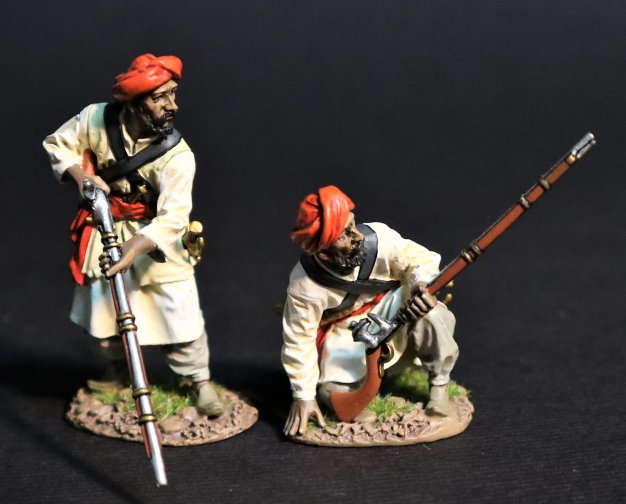
M-WIN-33
WELLINGTON IN INDIA,
THE BATTLE OF ASSAYE 1803,
THE MARATHA EMPIRE,
2 MARATHA INFANTRY
(2 pcs)
WELLINGTON IN INDIA
THE BATTLE OF ASSAYE 1803
THE 74[SUP]th[/SUP](HIGHLAND) REGIMENT OF FOOT
The regiment was raised in Glasgow by Major-General Sir Archibald Campbell for service in India in October 1787. In accordance with the Declaratory Act 1788 the cost of raising the regiment was recharged to the East India Company on the basis that the act required that expenses “should be defrayed out of the revenues” arising there.
The regiment embarked for India in February 1789 and took part in the Siege of Bangalore in February 1791 and the Siege of Seringapatam in February 1792 during the Third Anglo-Mysore War.
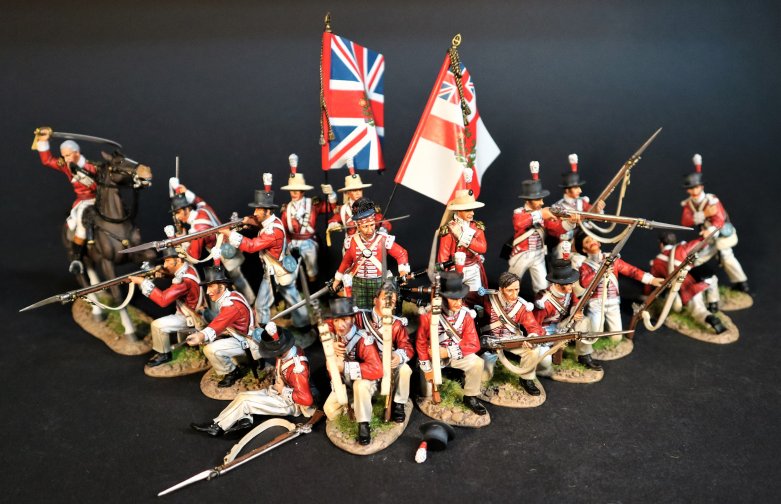
The 74[SUP]th[/SUP] (Highland) Regiment of Foot wore kilts and plaids of Government tartan from the time they were raised in 1787. However, they were soon ordered to India, where the regiment spent 18 years.
On arrival at Madras the kilt was discontinued as unsuitable. In 1803 the soldiers wore linen white trousers and black round hats.
Captain A. B. Campbell of the 74[SUP]th[/SUP], who had on a former occasion lost an arm, was seen in the thickest of the action with his bridle in his teeth, and a sword in his right hand, “dealing destruction around him”. He was to survive the battle although “one of the enemy in the charge very nearly transfixed him with the bayonet, which actually pierced his saddle”.
Wellesley’s infantry formed up in two lines on the far bank, with the British regiments on the outside flanks, the 74[SUP]th[/SUP] opposite Assaye, the 10[SUP]th[/SUP] Madras Native Infantry in the centre of the first line and the 4[SUP]th[/SUP] and 12[SUP]th[/SUP] Madras Native Infantry in the second.
The 19[SUP]th[/SUP] Light Dragoons and the 3 Madras cavalry regiments formed the reserve. The Mysore cavalry remained on the near bank of the Kaitna.
During the Battle of Assaye in 1803, Wellesley’s right flank was in turmoil. The commander of the right flank, Lieutenant Colonel William Orrock, had mistaken his orders and continued on an oblique path directly towards Assaye. The 74[SUP]th[/SUP] under command of Major Samuel Swinton had moved so far north, it created a large gap in the centre of the British line, and brought the units on the flank under a barrage of cannonade from the artillery around the village and the Maratha left. The two battalions began to fall back in disarray, and Pohlmann ordered his infantry and cavalry forward to attack. The Maratha cavalry virtually annihilated the pickets, but the remnants of the 74[SUP]th[/SUP] were able to form a rough square.
Realising the destruction of his right flank would leave his army exposed and outflanked, Wellesley ordered a detachment of British cavalry under Colonel Patrick Maxwell, consisting of the 19[SUP]th[/SUP] Light Dragoons and elements of the 4[SUP]th[/SUP] and 5[SUP]th[/SUP] Madras Native cavalry into action.
The cavalry dashed directly towards the 74[SUP]th[/SUP]’s square, crashed into the swarming Maratha cavalry and routed them.
The regiment remained on home service until 1810, when it was sent to the Peninsular War (1808-1814) for four years.
It fought at Busaco in 1810, Fuentes de Onoro in 1811, Ciudad Rodrigo, Badajoz, Salamanca in 1812, Vitoria, Nivelle, Orthes and Toulouse.
The Regiment saw service in Ireland at the time of Waterloo in 1815, and spent most of the following three decades in Canada and the West Indies.
In 1851, it arrived in the Cape Colony (in what is now South Africa) for the Eighth Cape Frontier War(1850-1853)
The troopship “Birkenhead” foundered off the coast of Southern Africa, the largest draft of new troops on board was intended for the 74[SUP]th[/SUP] foot. Their discipline on deck as the vessel sank, later known as the “Birkenhead Drill”, allowed the women and children on board to be saved.
The Regiment was to return to India in 1854, remaining there for ten years and fighting in the Indian Mutiny (1857-59)
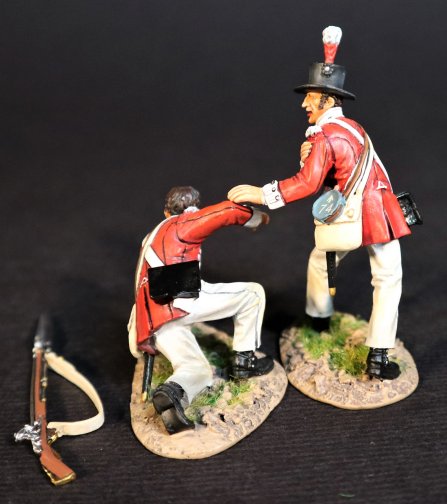
WIN74-14
WELLINGTON IN INDIA,
THE BATTLE OF ASSAYE 1803,
THE 74[SUP]th [/SUP](HIGHLAND) REGIMENT OF FOOT
2 LINE INFANTRY.
(3 pcs)
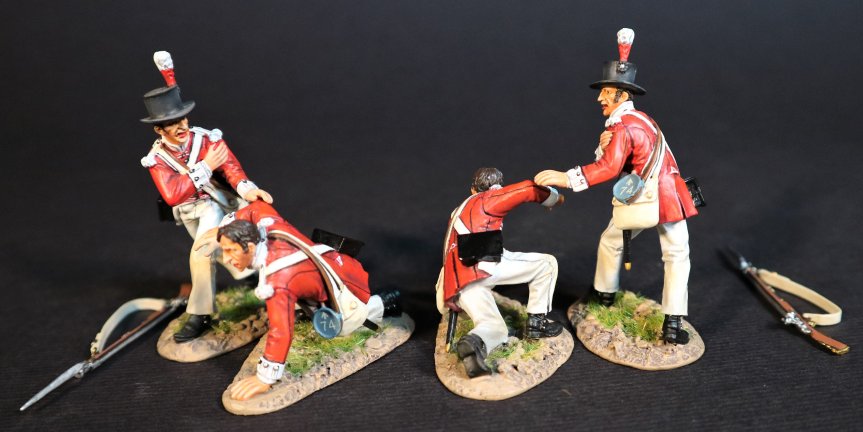
WIN74-14N
WELLINGTON IN INDIA,
THE BATTLE OF ASSAYE 1803,
THE 74[SUP]th [/SUP](HIGHLAND) REGIMENT OF FOOT
4 LINE INFANTRY.
(6 pcs)
**PLEASE CONTACT YOUR LOCAL DEALER FOR FURTHER INFORMATION**
WELLINGTON IN INDIA
THE BATTLE OF ASSAYE 1803
THE MARATHA EMPIRE
ARAB MERCENARY INFANTRY
The Battle of Assaye was a major battle of the Second Anglo-Maratha War fought between the Maratha Empire and the British East India Company. It occurred on 23[SUP]rd[/SUP] September 1803 near Assaye in Western India where an outnumbered Indian and British force under the command of Major General Arthur Wellesley (who later became the Duke of Wellington) defeated a combined Maratha army of Daulatrao Scindia and the Bhonsle Raja of Berar.
The battle was the Duke of Wellington’s first major victory and the one he later described as his finest accomplishment on the battlefield, even more so than his famous victories in the Peninsular War and his defeat of Napoleon Bonaparte at the Battle of Waterloo.

Kings, nobles and warlords have always imported mercenaries. Distrusting their own subjects, they placed faith on forces answering only to their benefactor. Through the ages, skilled and well-knit mercenary units have held inordinate power. Sometimes such units become so powerful that they turn on their employers on perceiving any threat. Sometimes, they even captured power. In India also, well-knit bands of Afghan, Turk, and African mercenaries have made great fortunes and captured power.
Arab mercenaries entered quite late in the game in India, when British supremacy had already emerged. Before the Arabs could expand their power in India — like so many foreign groups before them — their own benefactors and the British cut them down to size. However, their power and influence completely ended only in 1948.
The Sultans of Gujarat and the Deccan began employing Arab mercenaries in the 16th century. However, it was the Maratha campaigns of the 18th century that led to a huge influx. Arab mercenaries mostly hailed from Yemen’s Hadhramaut region, a land known for bold and enterprising people.
In the service of the Marathas, the Arabs gained reputation as extremely skilled and reliable fighters.
Thousands of Arabs served Maratha chieftains such as Scindia, Bhonsle and Gaekwad. Arab agents opened recruitment agencies in Indian ports, and some of these agents became very wealthy. Indian financiers also established ties with the Arabs to expand influence in Indian kingdoms.
Tribe and clan conflicts from the homeland existed in the mercenary units, but this did not dent their efficacy or their lustre.

M-WIN-23
WELLINGTON IN INDIA,
THE BATTLE OF ASSAYE 1803,
THE MARATHA EMPIRE,
2 MARATHA ARAB MERCENARIES
(2 pcs)
An Arab trooper was paid three times as much as a Deccani/Maratha trooper, and even more than a European mercenary.
However, their service depended entirely upon the regularity and size of the pay. When arrears mounted, the Arabs turned on their employers till they received their dues. In one instance, the Arab mercenaries even intervened in a political crisis in Baroda state. They imprisoned Maharaja Anandrao Gaekwad and his faction had to invite the East India Company’s army to retake control.
The British were aware of the threat posed by the Arab forces — and the Anglo-Maratha wars soon demonstrated how deadly Arab units could be.
When Britain finally concluded the Anglo-Maratha wars in 1818, she ensured that the Arab mercenaries were disbanded.
The British even paid the arrears so that the Arabs could leave immediately.
MARATHA INFANTRY


M-WIN-33
WELLINGTON IN INDIA,
THE BATTLE OF ASSAYE 1803,
THE MARATHA EMPIRE,
2 MARATHA INFANTRY
(2 pcs)
WELLINGTON IN INDIA
THE BATTLE OF ASSAYE 1803
THE 74[SUP]th[/SUP](HIGHLAND) REGIMENT OF FOOT
The regiment was raised in Glasgow by Major-General Sir Archibald Campbell for service in India in October 1787. In accordance with the Declaratory Act 1788 the cost of raising the regiment was recharged to the East India Company on the basis that the act required that expenses “should be defrayed out of the revenues” arising there.
The regiment embarked for India in February 1789 and took part in the Siege of Bangalore in February 1791 and the Siege of Seringapatam in February 1792 during the Third Anglo-Mysore War.

The 74[SUP]th[/SUP] (Highland) Regiment of Foot wore kilts and plaids of Government tartan from the time they were raised in 1787. However, they were soon ordered to India, where the regiment spent 18 years.
On arrival at Madras the kilt was discontinued as unsuitable. In 1803 the soldiers wore linen white trousers and black round hats.
Captain A. B. Campbell of the 74[SUP]th[/SUP], who had on a former occasion lost an arm, was seen in the thickest of the action with his bridle in his teeth, and a sword in his right hand, “dealing destruction around him”. He was to survive the battle although “one of the enemy in the charge very nearly transfixed him with the bayonet, which actually pierced his saddle”.
Wellesley’s infantry formed up in two lines on the far bank, with the British regiments on the outside flanks, the 74[SUP]th[/SUP] opposite Assaye, the 10[SUP]th[/SUP] Madras Native Infantry in the centre of the first line and the 4[SUP]th[/SUP] and 12[SUP]th[/SUP] Madras Native Infantry in the second.
The 19[SUP]th[/SUP] Light Dragoons and the 3 Madras cavalry regiments formed the reserve. The Mysore cavalry remained on the near bank of the Kaitna.
During the Battle of Assaye in 1803, Wellesley’s right flank was in turmoil. The commander of the right flank, Lieutenant Colonel William Orrock, had mistaken his orders and continued on an oblique path directly towards Assaye. The 74[SUP]th[/SUP] under command of Major Samuel Swinton had moved so far north, it created a large gap in the centre of the British line, and brought the units on the flank under a barrage of cannonade from the artillery around the village and the Maratha left. The two battalions began to fall back in disarray, and Pohlmann ordered his infantry and cavalry forward to attack. The Maratha cavalry virtually annihilated the pickets, but the remnants of the 74[SUP]th[/SUP] were able to form a rough square.
Realising the destruction of his right flank would leave his army exposed and outflanked, Wellesley ordered a detachment of British cavalry under Colonel Patrick Maxwell, consisting of the 19[SUP]th[/SUP] Light Dragoons and elements of the 4[SUP]th[/SUP] and 5[SUP]th[/SUP] Madras Native cavalry into action.
The cavalry dashed directly towards the 74[SUP]th[/SUP]’s square, crashed into the swarming Maratha cavalry and routed them.
The regiment remained on home service until 1810, when it was sent to the Peninsular War (1808-1814) for four years.
It fought at Busaco in 1810, Fuentes de Onoro in 1811, Ciudad Rodrigo, Badajoz, Salamanca in 1812, Vitoria, Nivelle, Orthes and Toulouse.
The Regiment saw service in Ireland at the time of Waterloo in 1815, and spent most of the following three decades in Canada and the West Indies.
In 1851, it arrived in the Cape Colony (in what is now South Africa) for the Eighth Cape Frontier War(1850-1853)
The troopship “Birkenhead” foundered off the coast of Southern Africa, the largest draft of new troops on board was intended for the 74[SUP]th[/SUP] foot. Their discipline on deck as the vessel sank, later known as the “Birkenhead Drill”, allowed the women and children on board to be saved.
The Regiment was to return to India in 1854, remaining there for ten years and fighting in the Indian Mutiny (1857-59)

WIN74-14
WELLINGTON IN INDIA,
THE BATTLE OF ASSAYE 1803,
THE 74[SUP]th [/SUP](HIGHLAND) REGIMENT OF FOOT
2 LINE INFANTRY.
(3 pcs)

WIN74-14N
WELLINGTON IN INDIA,
THE BATTLE OF ASSAYE 1803,
THE 74[SUP]th [/SUP](HIGHLAND) REGIMENT OF FOOT
4 LINE INFANTRY.
(6 pcs)
**PLEASE CONTACT YOUR LOCAL DEALER FOR FURTHER INFORMATION**

